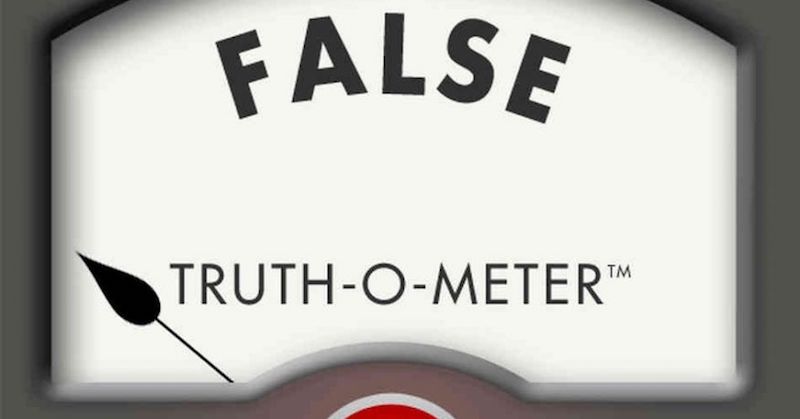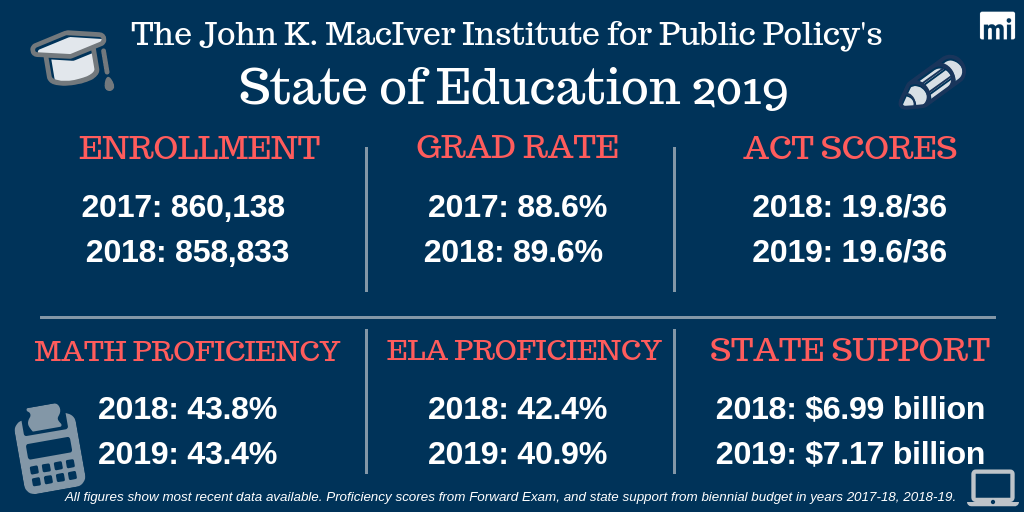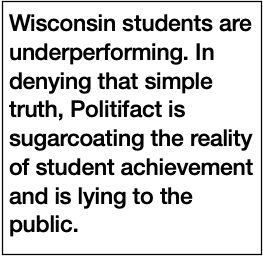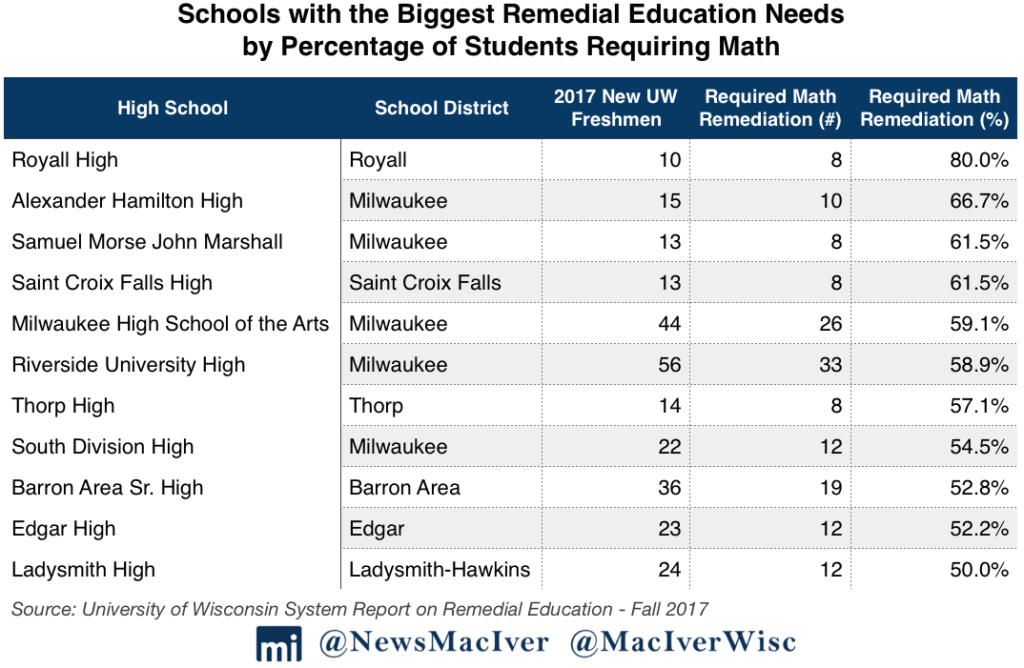 Sorry, Politifact, The Majority Of Wisconsin Students Are Performing Below Grade Level. Just Look At DPI's Own Data http://bit.ly/2qMdZR2 Click To Tweet
Fr @MacIverWisc It’s not pleasant to hear the sad truth about the poor performance of WI K12 students, but talking openly about achievement is the only way we can give future students a fighting chance http://bit.ly/2qMdZR2 Click To Tweet
Sorry, Politifact, The Majority Of Wisconsin Students Are Performing Below Grade Level. Just Look At DPI's Own Data http://bit.ly/2qMdZR2 Click To Tweet
Fr @MacIverWisc It’s not pleasant to hear the sad truth about the poor performance of WI K12 students, but talking openly about achievement is the only way we can give future students a fighting chance http://bit.ly/2qMdZR2 Click To Tweet
October 28, 2019
By Ola Lisowski
When proficiency numbers are hard facts, how far can parties go to deny the truth? Unfortunately for the public, organizations like Politifact go pretty far in twisting the data.
Let’s start with what we know.

Last month, Wisconsin’s Department of Public Instruction (DPI) published test results for the spring 2019 administration of the Forward Exam. Statewide, just 40.9 percent of all students are proficient or advanced in English language arts, down from 42.4 percent last year. In math, 43.4 percent of all students are proficient or advanced, down from last year’s 43.8 percent.
In the same data release, DPI also publicized results for the ACT with Writing and Dynamic Learning Maps Assessments (exams given to students with significant cognitive disabilities). Along with the Forward Exam, the trio of test results are called the Wisconsin Student Assessment System (WSAS).
Taken together, proficiency scores are actually lower than on the Forward Exam alone. Just 39.3 percent of all students are proficient or advanced in English language arts according to the WSAS, and 40.1 percent demonstrated proficiency or better in math. If you take the figures at face value, it’s tough to deny that the figures show a pretty sad state of affairs.
 Enter Rep. Jeremy Thiesfeldt, chair of the Assembly’s Education Committee. The Fond du Lac Republican wrote in a press release that “annual test scores released last month showed that 60 percent of Wisconsin students are not able to read or perform math at grade level.” In a radio address, Thiesfeldt pushed further, saying “the vast majority of Wisconsin students cannot even read, write, or do math at grade level.”
Enter Rep. Jeremy Thiesfeldt, chair of the Assembly’s Education Committee. The Fond du Lac Republican wrote in a press release that “annual test scores released last month showed that 60 percent of Wisconsin students are not able to read or perform math at grade level.” In a radio address, Thiesfeldt pushed further, saying “the vast majority of Wisconsin students cannot even read, write, or do math at grade level.”
Politifact gave the claim a “false” rating on its “truth-o-meter,” calling the definition a moving target and describing stated thresholds around the state for what “proficiency” tangibly means. They conclude that while proficient was once roughly equal to grade level, that’s no longer the case. Plus, federal standards show proficiency is a higher bar, “more akin to ‘mastery’ of a subject.”
That runs directly counter to DPI’s own stated policies, and is blatantly false.
Per DPI’s Performance Level Descriptors, a student who rates proficient “demonstrates adequate understanding of and ability to apply the knowledge and skills for their grade level that are associated with college content-readiness.” Students who are advanced demonstrate “thorough understanding” of material for their grade level. DPI adds the percentages of proficient and advanced students to find the total percent of students at or above grade level.
Students with scores of “basic” demonstrate “partial understanding” of the material, and students who are “below basic” demonstrate “minimal understanding” of the material.
DPI is the organization that publishes the data in question. The department has full ability to set its own definitions and expectations for what cut scores mean. And per DPI, proficient and advanced mean adequate or thorough understanding, respectively, while basic or below basic translate to partial or minimal understanding.
For all the hemming and hawing about what a cut score really means, Politifact obfuscates what’s really at play: Wisconsin students are underperforming, and they’re underperforming quite seriously.
Turning to data that compares us to other states is fine, but being above average on some metrics doesn’t mean we’re doing great. It means the education system in this country is largely broken and is not producing the results it should. When we consider 42 percent proficiency pretty good because the nation’s average is 40 percent, it shouldn’t be an achievement, but a warning call.
Students are not where they need to be.
Remedial education data is among the most enlightening in this regard. When entering the University of Wisconsin System, new freshmen have to take placement tests. Students who fare poorly on placement exams are required to take remedial math or English classes before moving onto degree coursework. Those classes come with full tuition but zero credits, and the data show students are less likely to graduate on time or finish their degrees at all.
In the fall of 2017, the most recent data available, students from 196 Wisconsin high schools were required to take remedial math or English upon entering the UW System. Rather than demonstrating mastery of material before graduating high school, thousands of students are moving through the system and are arriving at college unprepared.

What’s worse? Half of the high schools that received top marks from DPI on report cards just a month before the data release showed significant issues with remediation. Many of those schools’ home pages celebrate their five-star ratings, telling the public they’re among the best schools in the state. And yet significant numbers of graduates aren’t ready for college. It’s not just a shame.
It’s a sugar-coated lie.
We are lying to our students and parents. We’re lying to them about what proficiency and college readiness mean.
It’s not pleasant to hear the sad truth of poor performance, but talking openly about achievement is the only way we can give future students a fighting chance. We can’t adequately address the problem if we can’t look it in the face. When organizations like Politifact choose to deny the reality of our state’s own education statistics, they are lying to the public.
We rate Politifact’s claim false.